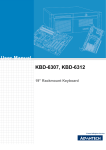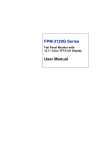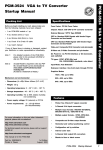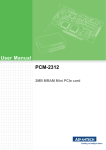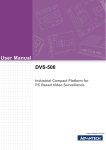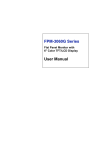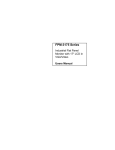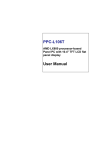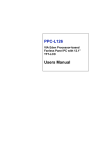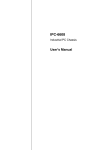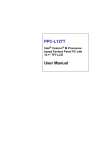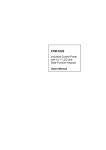Download PCM-3524 - Fairchild Engineering Ltd
Transcript
PCM-3524 VGA-to-TV PC/104 Module Users Manual Copyright This document is copyrighted, © 2002. All rights are reserved. The original manufacturer reserves the right to make improvements to the products described in this manual at any time without notice. No part of this manual may be reproduced, copied, translated or transmitted in any form or by any means without the prior written permission of the original manufacturer. Information provided in this manual is intended to be accurate and reliable. However, the original manufacturer assumes no responsibility for its use, nor for any infringements upon the rights of third parties that may result from such use. Acknowledgements Award is a trademark of Award Software International, Inc. VIA is a trademark of VIA Technologies, Inc. IBM, PC/AT, PS/2 and VGA are trademarks of International Business Machines Corporation. Intel and Pentium are trademarks of Intel Corporation. Microsoft Windows® is a registered trademark of Microsoft Corp. RTL is a trademark of Realtek Semi-Conductor Co., Ltd. ESS is a trademark of ESS Technology, Inc. UMC is a trademark of United Microelectronics Corporation. SMI is a trademark of Silicon Motion, Inc. Creative is a trademark of Creative Technology LTD. All other product names or trademarks are properties of their respective owners. For more information on this and other Advantech products, please visit our websites at: http://www.advantech.com http://www.advantech.com/epc For technical support and service, please visit our support website at: http://support.advantech.com This manual is for the PCM-3524. Part No. 2006352400 1st Edition, Printed in Taiwan August, 2002 PCM-3524 User’s Manual ii FCC Class B This equipment has been tested and found to comply with the limits for a Class B digital device, pursuant to Part 15 of the FCC Rules. These limits are designed to provide reasonable protection against harmful interference when the equipment is operated in a residential environment. This equipment generates, uses and can radiate radio frequency energy. If not installed and used in accordance with this user's manual, it may cause harmful interference to radio communications. Note that even when this equipment is installed and used in accordance with this user's manual, there is still no guarantee that interference will not occur. If this equipment is believed to be causing harmful interference to radio or television reception, this can be determined by turning the equipment on and off. If interference is occurring, the user is encouraged to try to correct the interference by one or more of the following measures: • Reorient or relocate the receiving antenna • Increase the separation between the equipment and the receiver • Connect the equipment to a power outlet on a circuit different from that to which the receiver is connected • Consult the dealer or an experienced radio/TV technician for help Warning! Any changes or modifications made to the equipment which are not expressly approved by the relevant standards authority could void your authority to operate the equipment. iii Packing List Before you begin installing your card, please make sure that the following materials have been shipped: • 1 ea. PCM-3524 module x 1 pc • 4 ea. Screws (3mm) x 4 pcs • 4 ea. Bronze stick (6mm) x 4 pcs • 1 ea. D-sub 15 to D-sub 15 cable • 1 ea. User's manual If any of these items are missing or damaged, contact your distributor or sales representative immediately. Additional Information and Assistance Step 1. Visit the Advantech web site at www.advantech.com where you can find the latest information about the product. Step 2. Contact your distributor, sales representative, or Advantech's customer service center for technical support if you need additional assistance. Please have the following information ready before you call: • Product name and serial number • Description of your peripheral attachments • Description of your software (operating system, version, application software, etc.) • A complete description of the problem • The exact wording of any error messages PCM-3524 User’s Manual iv Safety Instructions 1. Read these safety instructions carefully. 2. Keep this User's Manual for later reference. 3. Disconnect this equipment from any AC outlet before cleaning. Use a damp cloth. Do not use liquid or spray detergents for cleaning. 4. For plug-in equipment, the power outlet socket must be located near the equipment and must be easily accessible. 5. Keep this equipment away from humidity. 6. Put this equipment on a reliable surface during installation. Dropping it or letting it fall may cause damage. 7. The openings on the enclosure are for air convection. Protect the equipment from overheating. DO NOT COVER THE OPENINGS. 8. Make sure the voltage of the power source is correct before connecting the equipment to the power outlet. 9. Position the power cord so that people cannot step on it. Do not place anything over the power cord. 10. All cautions and warnings on the equipment should be noted. 11. If the equipment is not used for a long time, disconnect it from the power source to avoid damage by transient overvoltage. 12. Never pour any liquid into an opening. This may cause fire or electrical shock. 13. Never open the equipment. For safety reasons, the equipment should be opened only by qualified service personnel. 14. If one of the following situations arises, get the equipment checked by service personnel: a. The power cord or plug is damaged. b. Liquid has penetrated into the equipment. c. The equipment has been exposed to moisture. d. The equipment does not work well, or you cannot get it to work according to the user's manual. e. The equipment has been dropped and damaged. f. The equipment has obvious signs of breakage. 15. DO NOT LEAVE THIS EQUIPMENT IN AN ENVIRONMENT WHERE THE STORAGE TEMPERATURE MAY GO BELOW -20° C (-4° F) OR ABOVE 60° C (140° F). THIS COULD DAMAGE THE EQUIPMENT. THE EQUIPMENT SHOULD BE IN A CONTROLLED ENVIRONMENT. 16. CAUTION: DANGER OF EXPLOSION IF BATTERY IS INCORRECTLY REPLACED.REPLACE ONLY WITH THE SAME OR EQUIVALENT TYPE RECOMMENDED BY THE MANUFACTURER, DISCARD USED BATTERIES ACCORDING TO THE MANUFACTURER'S INSTRUCTIONS. The sound pressure level at the operator's position according to IEC 704-1:1982 is no more than 70 dB (A). DISCLAIMER: This set of instructions is given according to IEC 704-1. Advantech disclaims all responsibility for the accuracy of any statements contained herein. v Wichtige Sicherheishinweise 1. Bitte lesen sie Sich diese Hinweise sorgfältig durch. 2. Heben Sie diese Anleitung für den späteren Gebrauch auf. 3. Vor jedem Reinigen ist das Gerät vom Stromnetz zu trennen. Verwenden Sie Keine Flüssig-oder Aerosolreiniger. Am besten dient ein angefeuchtetes Tuch zur Reinigung. 4. Die NetzanschluBsteckdose soll nahe dem Gerät angebracht und leicht zugänglich sein. 5. Das Gerät ist vor Feuchtigkeit zu schützen. 6. Bei der Aufstellung des Gerätes ist auf sicheren Stand zu achten. Ein Kippen oder Fallen könnte Verletzungen hervorrufen. 7. Die Belüftungsöffnungen dienen zur Luftzirkulation die das Gerät vor überhitzung schützt. Sorgen Sie dafür, daB diese Öffnungen nicht abgedeckt werden. 8. Beachten Sie beim. AnschluB an das Stromnetz die AnschluBwerte. 9. Verlegen Sie die NetzanschluBleitung so, daB niemand darüber fallen kann. Es sollte auch nichts auf der Leitung abgestellt werden. 10. Alle Hinweise und Warnungen die sich am Geräten befinden sind zu beachten. 11. Wird das Gerät über einen längeren Zeitraum nicht benutzt, sollten Sie es vom Stromnetz trennen. Somit wird im Falle einer Überspannung eine Beschädigung vermieden. 12. Durch die Lüftungsöffnungen dürfen niemals Gegenstände oder Flüssigkeiten in das Gerät gelangen. Dies könnte einen Brand bzw. elektrischen Schlag auslösen. 13. Öffnen Sie niemals das Gerät. Das Gerät darf aus Gründen der elektrischen Sicherheit nur von authorisiertem Servicepersonal geöffnet werden. 14. Wenn folgende Situationen auftreten ist das Gerät vom Stromnetz zu trennen und von einer qualifizierten Servicestelle zu überprüfen: a - Netzkabel oder Netzstecker sind beschädigt. b - Flüssigkeit ist in das Gerät eingedrungen. c - Das Gerät war Feuchtigkeit ausgesetzt. d - Wenn das Gerät nicht der Bedienungsanleitung entsprechend funktioniert oder Sie mit Hilfe dieser Anleitung keine Verbesserung erzielen. e - Das Gerät ist gefallen und/oder das Gehäuse ist beschädigt. f - Wenn das Gerät deutliche Anzeichen eines Defektes aufweist. 15. VOSICHT: Explisionsgefahr bei unsachgemaben Austausch der Batterie.Ersatz nur durch densellben order einem vom Hersteller empfohlenemahnlichen Typ. Entsorgung gebrauchter Batterien navh Angaben des Herstellers. Der arbeitsplatzbezogene Schalldruckpegel nach DIN 45 635 Teil 1000 beträgt 70dB(A) oder weiger. DISCLAIMER: This set of instructions is given according to IEC704-1. Advantech disclaims all responsibility for the accuracy of any statements contained herein. PCM-3524 User’s Manual vi Contents Chapter 1 General Information ........................................2 1.1 1.2 1.3 Introduction ....................................................................... 2 Features ............................................................................. 2 Board Layout..................................................................... 3 1.3.1 1.3.2 Chapter Placement ....................................................................... 3 Figure 1.1:Component Placement................................... 3 Module Dimensions ....................................................... 4 Figure 1.2:Dimensions.................................................... 4 2 Installation ........................................................6 2.2 Jumper Settings ................................................................. 7 2.2.1 2.2.2 2.2.3 2.2.4 2.2.5 2.3 Connectors......................................................................... 9 2.3.1 2.3.2 2.3.3 2.3.4 2.3.5 2.3.6 2.4 Table 2.3:Connectors ...................................................... 9 VGA Connector (CN2/CN3 16-pin)............................... 9 VGA Connector (CN1/CN4 15-pin)............................. 10 Composite Video Output Connector (CN5/J1)............. 10 DC Power Connector (CN6)......................................... 10 DC Power Connector Jack (J2)..................................... 10 S-Video Output Connector (CN7/J3) ........................... 10 Switches and VR ............................................................. 11 2.4.1 2.4.2 2.4.3 2.4.4 2.4.5 2.4.6 2.4.7 2.4.8 2.5 Table 2.1:Jumpers........................................................... 7 PAL/NTSC Video Output Select (JP1, JP2, JP4):.......... 7 Table 2.2:Output Mode Settings..................................... 7 PWRDN Power-Down Control (JP5) ............................. 8 RGB_OUT Enable (JP6) ................................................ 8 YUV_OUT Enable (JP8) ................................................ 8 POWER Selection (JP14) ............................................... 8 Table 2.4:Switches........................................................ 11 Reset (SW1).................................................................. 11 Position controls (SW2~5)............................................ 11 Table 2.5:Position Adjustment Switches ...................... 11 ZOOM TOGGLE (SW6) .............................................. 12 BLANK (SW7) ............................................................. 12 FREEZE (SW8) ............................................................ 12 FILTER MODE SELECTION (SW9).......................... 12 OVERSCAN (SW10) ................................................... 12 BRIGHTNESS (VR1)................................................... 12 Implementation of the PCM-3524................................... 13 2.5.1 2.5.2 Standalone..................................................................... 13 Plugged into Single Board Computer .......................... 13 vii PCM-3524 User’s Manual viii CHAPTER 1 General Information This chapter gives background information on the PCM-3524 VGAto-TV PC/104 Module. Sections include: • Introduction • Features • Board Layout 1 Chapter 1 Chapter 1 General Information 1.1 Introduction The PCM-3524 converts RGB video and sync from a standard VGA source into broadcast quality NTSC or PAL video. Composite and SVideo outputs are compliant with SMPTE-170M and CCIR-656 specifications. A fully integrated 3-line adaptive flicker filter provides three selectable operating modes. The PCM-3524 conforms to NTSC and PAL standards using a single low-cost application circuit. Included is all of the active circuitry required to generate a television signal with outstanding image quality in a standalone application. Incoming VGA source signals must be within a ±2% tolerance of 2X the frame and 2X the line rate of the outgoing TV standard. 1.2 Features • Flicker free VGA-to-TV signal converter • 3-Channel 8 bit input conversion • Multiple input formats: 640x480 60/75/85Hz, 800x600 60/75 Hz, 1024x768 60 Hz • Multiple output formats - NTSC, NTSC-EIA, PAL-B/G/H/I • Composite and S-video output formats • Horizontal and vertical positioning control • Configuration set by switches • Internal color bars • 3-Channel 9-bit output D/A converters • Blanks to blue or black screen PCM-3524 User’s Manual 2 1.3 Board Layout 1.3.1 Placement JP12 JP11 JP10 JP9 JP8 JP7 JP6 JP5 JP4 JP3 JP2 JP1 SW10 SW9 SW8 SW7 SW6 SW5 SW4 SW3 SW2 SW1 16 15 1 2 CN3 CN1 VR1 CN2 CN4 12 8 2 103 15 1 16 102 J1 U3 J2 38 DC_9V 65 +12V GND CN6 GND 1 OSC1 3 +5V CN5 1 64 39 JP14 J3 3 1 4 2 CN7 J4 64 2 63 D4 J5 2 40 1 39 AX10433 Figure 1.1: Component Placement 3 Chapter 1 General Information 7.62 79.81 1.3.2 Module Dimensions 95.89 90.81 69.65 45.03 44.54 32.19 27.43 5.08 PCM-3524 User’s Manual 4 0.00 13.72 Figure 1.2: Dimensions 8.64 78.74 85.09 0.00 90.17 0.00 CHAPTER 2 Installation This chapter gives installation information on the PCM-3524 VGA-to-TV PC/104 Module. Sections include: • Jumper Settings • Connectors • Switches • Implementation 5 Chapter 2 Chapter 2 Installation 2.1 Jumpers You may configure your card to match the needs of your application by setting jumpers. A jumper is a metal bridge used to close an electric circuit. It consists of two metal pins and a small metal clip (often protected by a plastic cover) that slides over the pins to connect them. To “close” a jumper, you connect the pins with the clip. To “open” a jumper, you remove the clip. Sometimes a jumper will have three pins, labeled 1, 2 and 3. In this case you would connect either pins 1 and 2, or 2 and 3. open closed closed 2-3 The jumper settings are schematically depicted in this manual as follows:. open closed closed 2-3 A pair of needle-nose pliers may be helpful when working with jumpers. If you have any doubts about the best hardware configuration for your application, contact your local distributor or sales representative before you make any changes. Generally, you simply need a standard cable to make most connections. PCM-3524 User’s Manual 6 2.2 Jumper Settings Making the proper jumper settings to configure the PCM-3524 to match the needs of your application. Table 2.1: Jumpers JUMPER JP1 JP2 JP3 JP4 JP5 JP6 JP7 JP8 JP9 JP10 JP11 JP12 JP14 NAME TD0 TD1 RESERVED PAL_NTSC PWRDN RGB_OUT RESERVED YUV_OUT RESERVED RESERVED RESERVED RESERVED POWER Selection Default Short Short Open Short Short Short Open Short Open Open Open Open Short 2-3 2.2.1 PAL/NTSC Video Output Select (JP1, JP2, JP4): Timing, sub-carrier frequency, and phase parameters are preprogrammed into the module and correspond to worldwide NTSC and PAL standards. Use TD0 and TD1 to select one of four sets of parameters to set up the encoder. The frame rate of the graphics source must be twice the frame rate of the selected video standard. Please see Table 2.2 Table 2.2: Output Mode Settings NTSC NTSC-EIA PAL-BDGHI PAL-N PAL-Comb-N PAL-M JP4 Short Short Open Open Open Short JP2 Short Short Short Short Open Open 7 JP1 Short Open Open Short Open Short Chapter 2 Installation 2.2.2 PWRDN Power-Down Control (JP5) When closed, the PCM-3524 is fully operational and enabled. When opened, the PCM-3524 is configured for minimum power consumption. D/A converters and clocks are disabled. Previously established set-up conditions are retained and remain in effect when PWRDN is shorted again. 2.2.3 RGB_OUT Enable (JP6) When opened to ON, the PCM-3524 is configured for RGB output, the COMPOSITE, LUMA, and CHROMA will output R, G, and B respectively. When shorted to OFF, RGB output is disabled. 2.2.4 YUV_OUT Enable (JP8) When open to ON, the PCM-3524 is configured for YUV output, the COMPOSITE, LUMA, and CHROMA will output Y, U, and V respectively. When short to OFF, YUV output is disabled. 2.2.5 POWER Selection (JP14) When short 1-2, the power source from +5V. When short 2-3, the power source from regulator. PCM-3524 User’s Manual 8 2.3 Connectors Table 2.3: Connectors Label CN1 CN2 CN3 CN4 CN5 CN6 CN7 J1 J2 J3 Function VGA output (DB15 female) VGA output (16-pin box-header) VGA input (16-pin box-header) VGA input (DB15 female) Composite Video output (2-pin header) DC power in S-Video output (4-pin header) Composite Video output (RCA jack) DC power in (DC power jack) S-Video output (4pin mini-DIN) 2.3.1 VGA Connector (CN2/CN3 16-pin) Pin 1 4 7 10 Signal Red N/A N/A AGND Pin 2 5 8 11 Signal AGND Blue DDC DAT GND Pin 3 6 9 12 13 16 AGND N/C 14 Vert Sync 15 9 Signal Green AGND GND Horz Sync DDC CLK 1 2 3 4 5 6 7 9 8 10 11 13 15 12 14 16 Chapter 2 Installation 2.3.2 VGA Connector (CN1/CN4 15-pin) Pin 1 4 7 10 13 Description Red N/A AGND GND Horz Sync Pin 2 5 8 11 14 Description Green GND AGND N/A Vert Sync Pin 3 6 9 12 15 Description Blue AGND N/A DDC DAT DDC CLK 2.3.3 Composite Video Output Connector (CN5/J1) Pin 1 2 Signal COMP GND 2.3.4 DC Power Connector (CN6) Pin 1 2 Signal +12V GND Pin 3 4 Signal GND +5V 2.3.5 DC Power Connector Jack (J2) 6~12V @ 600mA (9V Recommended) 2.3.6 S-Video Output Connector (CN7/J3) Pin 1 2 3 4 Signal GND CSYNC CHROMA LUMA PCM-3524 User’s Manual 10 2.4 Switches and VR Table 2.4: Switches SWITCH SW1 SW2 SW3 SW4 SW5 SW6 SW7 SW8 SW9 SW10 VR1 FUNCTION RESET POS_U POS_L POS_R POS_D ZOOM BLANK OUPUT FREEZE OUTPUT FILTER MODE SELECTS OVERSCAN OR UNDERSCAN BRIGHTNESS All switches are pin-headers. Some sort of switches must be connected, such as a button switches. 2.4.1 Reset (SW1) Momentary contact reboots the system. 2.4.2 Position controls (SW2~5) The position controls change the processor timing relative to incoming video so that the viewed image may be shifted right or down, to reveal portions of the image that may be found near the edges or in the overscan areas. Vertical position is adjusted 2 lines per frame, for a total of 128 lines. Video image will revert to the most upper left position. In the 4-toggle position mode, reversion is not supported and all 4 positioning controls have to be used in order to scroll back the image. During Zoom operation, the 4 positioning controls remain available, and are used for panning the image across the active video area. Table 2.5: Position Adjustment Switches Switch SW2 SW3 SW4 SW5 Position adjustment up left right down 11 Chapter 2 Installation 2.4.3 ZOOM TOGGLE (SW6) When SW6 is pulsed, the video image size doubles in both the horizontal and vertical directions (this makes the image 4x larger). The video image display can be set back to normal size by another pulse. 2.4.4 BLANK (SW7) When closed, a blank blue screen is displayed. 2.4.5 FREEZE (SW8) When closed, writing to the external field store devices stops on the next falling edge of VSYNC. When open, writing to the external field store devices resumes on the next falling edge of VSYNC. 2.4.6 FILTER MODE SELECTION (SW9) Vertical Filter Mode select. The 3-line flicker reduction filter may be configured for 3-line filtering, 2-line filtering, and no vertical filtering modes. Pulsing the FILTER control will cycle through the different filtering modes. 3-lineÆ2-lineÆno filterÆcolor barsÆno filterÆ2-lineÆ3-line 2.4.7 OVERSCAN (SW10) The video output is toggled between underscan and overscan. OVERSCAN is only available at 640 x 480 resolution. 2.4.8 BRIGHTNESS (VR1) This VR adjusts brightness output. PCM-3524 User’s Manual 12 2.5 Implementation of the PCM-3524 There are two basic ways to implement the PCM-3524 into your system: 2.5.1 Standalone The user may adapt an AC-to-DC power supply, plug it into PCM-3524’s CN6 or J2, and connect the VGA input to CN3 or CN4 to convert the VGA RGB signal into a TV signal. 2.5.2 Plugged into Single Board Computer The user can plug PCM-3524 into the PC/104 connector on the related SBC for the power supply, and connect the VGA input to CN3 or CN4 to convert the VGA RGB signal into a TV signal. Note: When attaching to a PC/104 connector, please make sure that you orient the PCM-3524 to the host board correctly. Don’t attach it 180 degrees off! 13 Chapter 2 Installation PCM-3524 User’s Manual 14






















